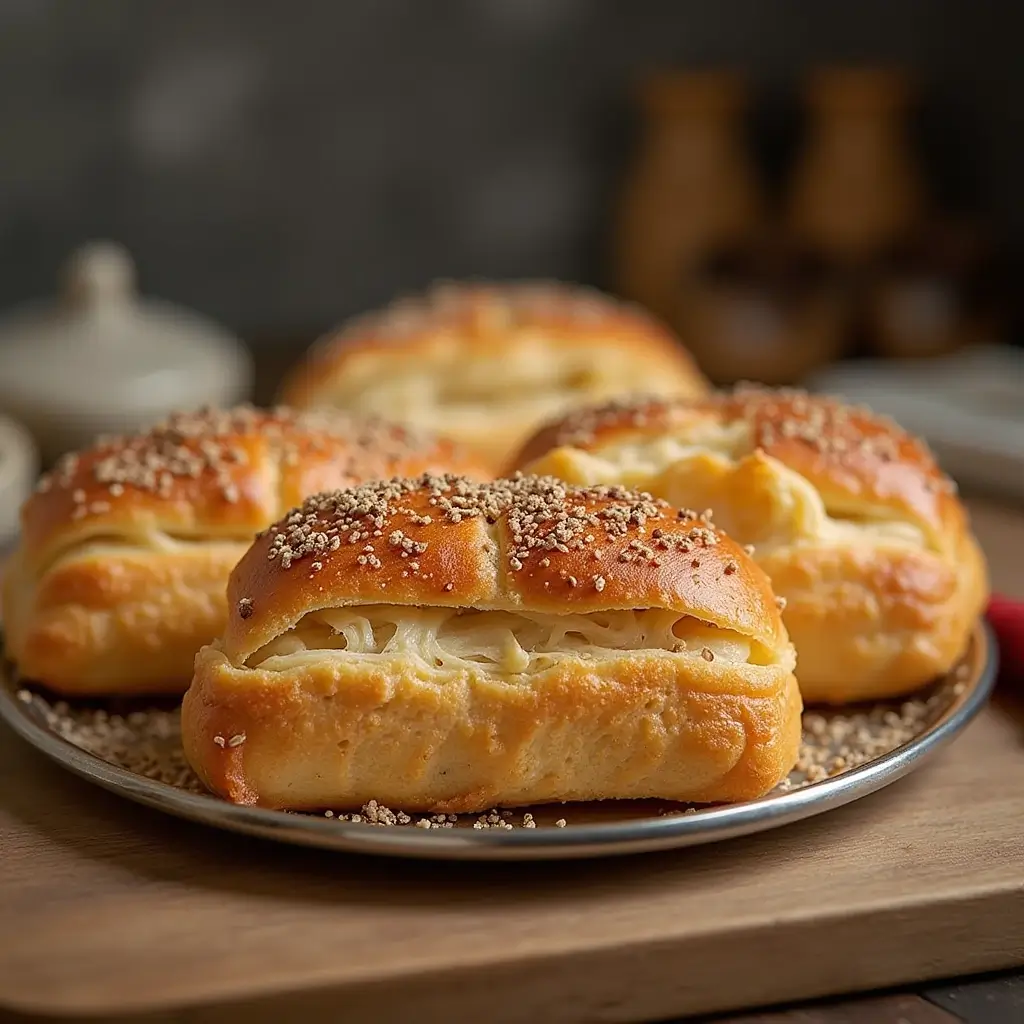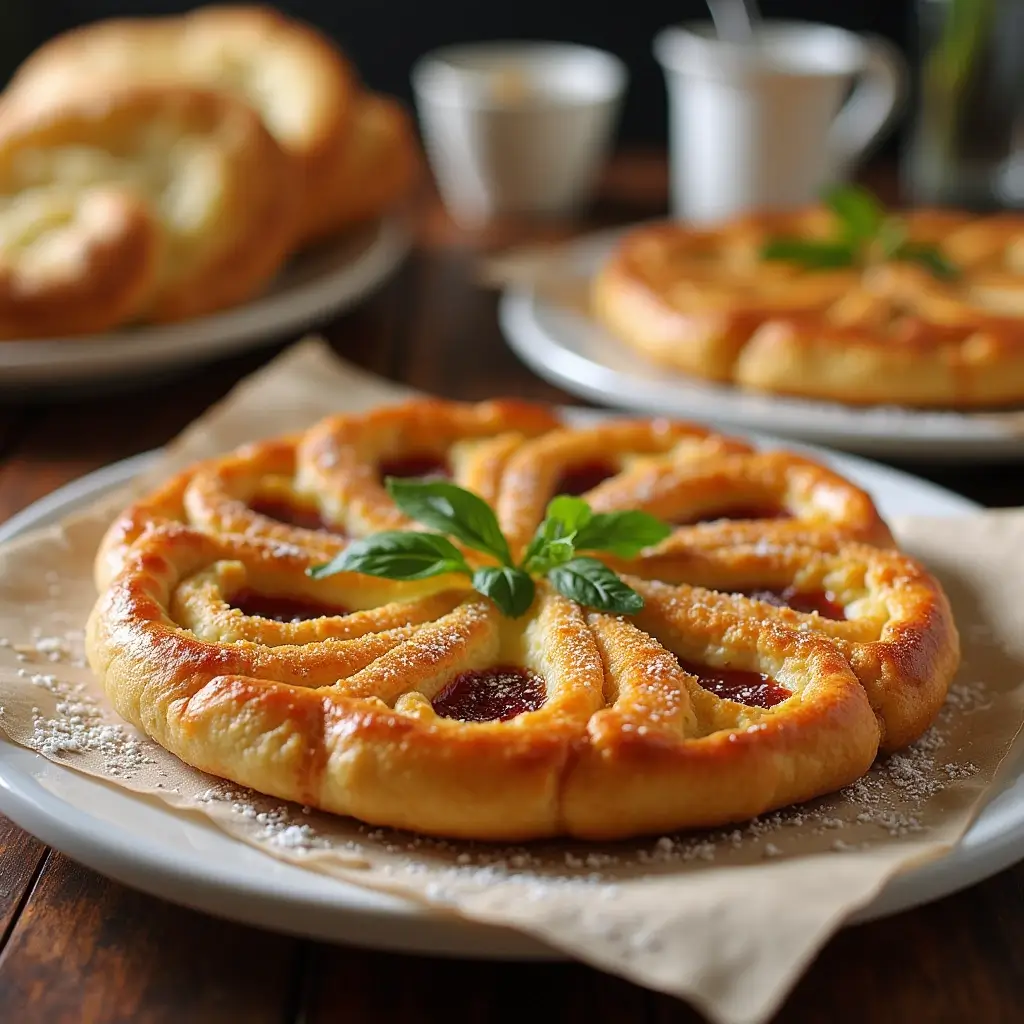Introduction
Persian pastries are a true treasure of Iranian cuisine, blending subtle flavors and refined ingredients such as saffron, rose water, and cardamom. Renowned for their delicacy and aromatic richness, they are often served on special occasions such as Nowruz (Persian New Year) or Yalda Night.
Whether you’re a fan of exotic sweets or passionate about world cuisine, learning to make these delights at home is both a delicious and enriching experience. In this article, we reveal authentic recipes for must-try Persian pastries, along with tips on using traditional ingredients to successfully recreate these treats with ease.
Get ready for a unique culinary journey to the heart of Persia, where every bite tells a story of tradition and ancestral craftsmanship!
Read more : Easy Chicken Pastry
1. Must-Try Persian Pastries
Persian Baklava – A Flavor Explosion
Persian baklava stands out as one of the highlights of Persian pastry recipes. This Iranian version of baklava offers a unique take on traditional Iranian sweets, combining thin, crispy pastry layers with a rich nut filling, mainly pistachios and almonds. This dessert exemplifies the excellence of authentic Persian baking, where every detail matters to create a true explosion of flavors.
What makes Persian baklava special is the use of signature ingredients such as saffron and rose water, making it one of the finest examples of saffron and rosewater desserts. These delicate aromas, combined with a hint of cardamom, enhance the natural sweetness of homemade Persian sweets, offering a refined alternative to other Middle Eastern desserts.
In crafting this Iranian pastry, the balance between the crispiness of the pastry and the softness of the filling is essential. Tips for perfecting this dessert include using high-quality butter for optimal texture and precisely measuring spices to avoid overpowering the delicate flavors of Persian sweet treats. Each bite transports you to the heart of a rich culinary tradition, celebrated during festive events like Nowruz or Yalda Night.

By mastering these techniques, you can create Persian baklava worthy of the best Persian dessert shops. This dessert, a true showcase of Iranian confectionery, is sure to delight lovers of authentic sweets and bring an exotic touch to your table.
Zoolbia and Bamieh – Sweet Syrup-Soaked Fritters
Zoolbia and Bamieh are essentials in traditional Iranian sweets and Persian desserts. These syrup-soaked fritters perfectly illustrate the art of authentic Persian baking and are an integral part of Iranian confectionery.
Zoolbia, recognizable by their spiral shape, are made from a light and crispy batter. Once fried, they are immediately soaked in a fragrant syrup flavored with orange blossom, often enriched with saffron and rose water, making them a prime example of saffron and rosewater desserts. Their delicate texture and sweet taste offer a true explosion of flavors, captivating fans of homemade Persian sweets.
Bamieh, on the other hand, resemble small churros, with a soft interior and slightly crispy exterior. They are also dipped in the same sweet syrup, ensuring a perfect harmony between sweetness and smoothness. These Persian sweet treats stand out for their simplicity and ability to please, while being deeply rooted in the tradition of Middle Eastern desserts.
Served during festive occasions like Nowruz or Ramadan, Zoolbia and Bamieh represent more than just a dessert—they reflect a rich culinary heritage and ancestral expertise. By mastering these authentic Persian baking techniques, you can recreate these irresistible delights at home, adding a touch of exoticism and tradition to your table.
Qottab – Almond and Walnut-Filled Pastry
Qottab is a true gem among Persian pastry recipes and is one of the most beloved traditional Iranian sweets. Originating from Yazd, this iconic treat is a perfect example of authentic Persian baking. Qottab is distinguished by its delicate and light pastry, carefully shaped to encase a generous filling made of almonds, walnuts, and sometimes pistachios.
This stuffed pastry features a subtle balance between a crispy outer layer and a soft, flavorful center. The filling is meticulously prepared and often infused with spices like cardamom, adding an aromatic dimension similar to those found in saffron and rosewater desserts. These signature ingredients make Qottab a must-have in the world of Persian desserts and homemade Persian sweets.
Fans of Middle Eastern desserts will appreciate the versatility of this recipe. Qottab pairs perfectly with a cup of Persian tea, creating a delightful harmony between sweetness and spice. By mastering traditional techniques, you can recreate this ancestral delicacy and incorporate it into your culinary repertoire, bringing an authentic touch of Iranian confectionery to your table.
In summary, Qottab is more than just a stuffed biscuit—it’s an invitation to explore the rich traditions of Iranian cuisine, where every bite tells a story of passion, tradition, and finesse.
2. Key Ingredients for Authentic Persian Pastries
The Importance of Saffron and Rose Water in Iranian Cuisine
Saffron and rose water hold an essential place in authentic Persian baking and are the cornerstones of many traditional Iranian sweets. These two iconic ingredients are not only used for their unique flavors but also symbolize the heritage and elegance of Iranian cuisine.
Saffron, recognized as one of the world’s most precious spices, adds not only a deep golden color to desserts but also an unparalleled aromatic depth. In Persian pastry recipes, saffron is often infused into syrups or directly incorporated into the dough, adding a luxurious touch to desserts like Persian baklava and other Middle Eastern desserts. This spice enhances the flavor and brings out subtle notes that perfectly complement other ingredients.
Rose water, on the other hand, plays an equally crucial role. Appreciated for its delicate floral aroma, it is an essential ingredient in saffron and rosewater desserts. Rose water is used to flavor fillings and syrups that accompany homemade Persian sweets. Its careful use creates a balance between sweetness and acidity, resulting in Persian sweet treats that captivate with their complexity and finesse.
By combining saffron and rose water, Iranian chefs craft refined desserts that embody the essence of Persian cuisine. These ingredients, passed down through generations, not only provide a burst of flavors but also offer an authentic cultural experience, making every bite a true celebration of Iranian culinary heritage.
Dried Fruits and Spices: Essential Flavors
In the world of Persian pastry recipes and traditional Iranian sweets, dried fruits and spices play a central role. Almonds, pistachios, dates, and walnuts add a richness of textures and flavors, transforming each preparation into an authentic delight. These ingredients are found in many Persian desserts and homemade Persian sweets, giving Persian delicacies their unique character.
Spices such as cardamom, cinnamon, and even a hint of saffron—a staple in saffron and rosewater desserts—enhance these recipes by adding an aromatic depth that perfectly complements the natural sweetness of dried fruits. This masterful blend of aromas is a signature of authentic Persian baking, where each spice is carefully measured to balance the taste and create an unforgettable Persian sweet treat.
These combinations are not merely random; they are an integral part of Iranian confectionery traditions and can also be found in various Middle Eastern desserts. By incorporating these quality ingredients into your recipes, you invite your guests on a flavorful journey rich in history while highlighting the finesse and diversity of Iranian cuisine
3 -Easy Persian Pastry Recipes to Make at Home
Shirini Napeloni – The Iranian Puff Pastry
Shirini Napeloni is an iconic treat among Persian pastry recipes and holds a prominent place in the world of traditional Iranian sweets. This puff pastry, renowned for its lightness and multiple crispy layers, embodies the essence of authentic Persian baking. Preparing it requires a delicate mastery of puff pastry, which is stretched and folded to create thin layers, ensuring a texture that is both airy and crisp.
This dessert, highly appreciated among homemade Persian sweets, stands out for its rich and fragrant filling. Traditionally, the cream or nut mixture inside is enhanced with signature flavors such as saffron and rosewater—two key ingredients in saffron and rosewater desserts. Sometimes, a touch of cardamom is added to elevate the harmony of flavors, transforming each bite into a delightful Persian sweet treat.

Often served at festive occasions or alongside a cup of Persian tea, Shirini Napeloni is more than just a dessert. It is an invitation to explore the richness of Iranian culinary tradition and stands as one of the gems of Persian desserts, influenced by both Eastern and Mediterranean flavors. Whether you are passionate about Middle Eastern desserts or simply looking for a new taste experience, this recipe will bring an exotic and elegant touch to your table.
Naan-e Berenji – Persian Rice and Rose Cookies
Naan-e Berenji is a jewel among Persian pastry recipes and is one of the most beloved traditional Iranian sweets, known for its light texture and delicately fragrant taste. Made primarily with rice flour, this cookie is naturally crispy yet melt-in-the-mouth, offering a unique alternative to classic Middle Eastern desserts.
One of the secrets of these Persian cookies lies in the use of rosewater, a key ingredient in saffron and rosewater desserts, which adds a subtle and refined floral note. This blend of ingredients creates a perfect balance between the sweetness of rice and the aromatic delicacy, making these cookies irresistible homemade Persian sweets.
To intensify the flavor experience, some recipes include a hint of saffron. This additional touch, characteristic of authentic Persian baking, not only enhances the golden color of the cookies but also provides a depth of taste that perfectly complements the sweetness of rosewater. Each bite of Naan-e Berenji thus becomes a true Persian sweet treat, showcasing the richness and refinement of Iranian confectionery.
These cookies are ideal for pairing with a cup of Persian tea or for finishing a meal on a light and sophisticated note. By mastering this recipe, you can bring an authentic piece of Iranian culinary tradition into your home and invite your guests to discover the subtle art of Persian pastry-making.
Ranginak – The Date and Walnut Dessert
Ranginak is an exquisite example of Persian pastry recipes that perfectly fits into the tradition of traditional Iranian sweets. This dessert, loved for its simplicity and naturally rich flavors, combines the sweetness of dates with the crunch of walnuts to create an exceptional Persian sweet treat. Often prepared as part of authentic Persian baking, it stands out as a must-have among Persian desserts and homemade Persian sweets.
Traditionally, Ranginak is made by mixing pitted dates with finely chopped walnuts, sometimes enhanced with spices such as cardamom, adding an aromatic depth reminiscent of certain saffron and rosewater desserts. The soft texture of dates pairs perfectly with the crunch of walnuts, creating a subtle and harmonious contrast that delights the taste buds. This dessert is often served on festive occasions, forming part of the rich heritage of Iranian confectionery and Middle Eastern desserts.
In addition to its traditional preparation, some modern variations incorporate a touch of rosewater or even a pinch of saffron to further elevate the flavor. These adaptations allow Ranginak to be reimagined while remaining true to its roots, creating an even more refined version of this classic dessert. Whether enjoyed with Persian tea or as a delightful meal finale, Ranginak offers an authentic and unforgettable taste experience.
Conclusion
In conclusion, exploring these Persian pastry recipes takes you into a world of rich and delicious flavors, where each dessert tells the story of an ancient craft. Whether through the delicacy of Persian baklava, the sweetness of Zoolbia and Bamieh, or the finesse of Qottab, each recipe embodies the excellence of traditional Iranian sweets and reflects the art of authentic Persian baking.
The combination of precious ingredients such as saffron, rosewater, dried fruits, and spices transforms these homemade Persian sweets into true Persian sweet treats, inviting you to experience new flavors while celebrating Iranian traditions. These recipes, while rooted in Middle Eastern desserts, also offer a modern and accessible touch for those who wish to recreate the authenticity of Persian cuisine at home.
Try these recipes to turn your kitchen into a place of sharing and exotic flavors, and let yourself be transported by the magic of Iranian tastes.


1 thought on “Persian Pastry Recipes: How to Make Authentic Iranian Sweets at Home”
Comments are closed.